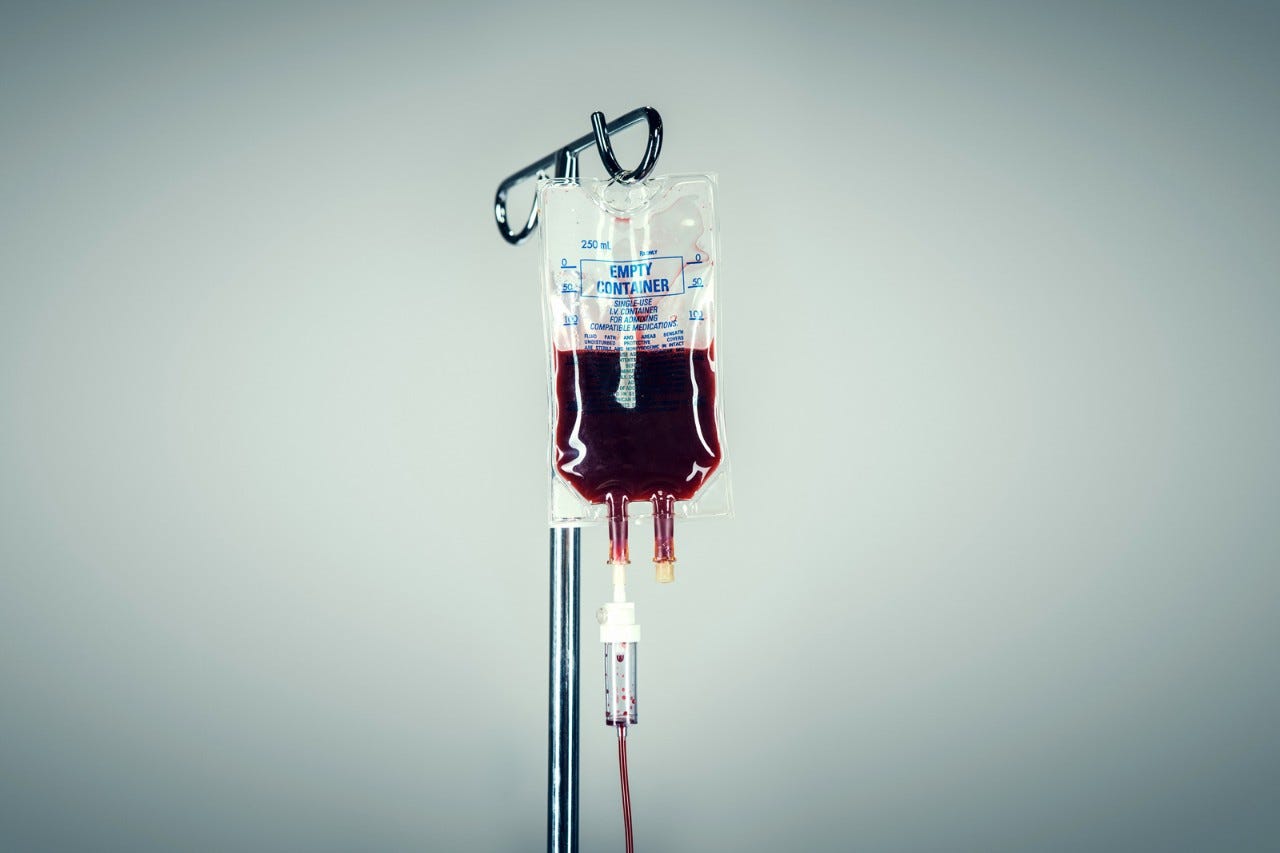Blood: myths and facts
Blood supplies our body with oxygen and nourishment, purifies, closes wounds, warms and protects against infection. But what do we know about our elixir of life?

- How much blood flows through our veins?
- How many litres of blood does the heart pump through the body a day?
- What is blood made of?
- Why is blood red?
- Do aristocrats have blue blood?
- How does a person get their blood group?
- What is golden blood?
- Do people with certain blood groups get sick more often?
- Can blood be produced artificially?
- Why do we need blood from other people?
- Can blood get sick?
- How much blood do women lose during their period?
- Can dark chocolate reduce blood pressure?
- Does “sweet” blood attract mosquitoes?
- Is blood a remedy?
How much blood flows through our veins?
Many people know that the human body is made up of over 50% water. But how many litres of blood actually flow around our body? “It depends on a person’s weight and height,” says Wolfram Weinrebe. "A person of average weight has a blood volume of about 5 to 8 percent of their weight." For a man weighing 70 kilograms, that's about 5 liters. By the way: women have around 1 liter less blood than men.
How many litres of blood does the heart pump through the body a day?
“Around 10,000 litres”, says Weinrebe. “However, the value of 5 litres per minute is much more important for everyone on the intensive care unit. This way we can estimate how much blood a person needs in an emergency.”
Fun fact: Completely new blood flows through our veins every three months.
What is blood made of?
The saying “Blood is thicker than water” is true both literally and figuratively. And the reason for this can be seen in the laboratory as it consists of around 45% solid cells and particles. These float in the plasma that makes up the remaining 55%.
-
If you want to know the details ...
Red blood cells, called erythrocytes, transport oxygen from the lungs to the tissues. They also regulate the removal of waste products that are produced in the cells. Leukocytes, i.e. the white blood cells, are the body’s soldiers and cleaning squad; they ward off pathogens and remove dead cells. Platelets, the thrombocytes, are needed by the body for blood clotting. And plasma is a nutrient-rich fluid that influences blood clotting and infection defence, balances water and salt levels, drains tissue and ensures heat transport within the body.
Why is blood red?
In actual fact, only a small portion of blood is red. The red blood cells are responsible for the colour. They carry an iron-containing protein molecule called haemoglobin. The iron it contains binds oxygen – a chemical reaction between iron and oxygen gives the blood its typical colour.
-
If you want to know the details ...
Most animals also have red blood – but not all of them. Arthropods such as crabs and spiders, and molluscs such as mussels and squid, for example, have blue blood. Why? Unlike iron-containing haemoglobin, the oxygen in the haemocyanin is bound by copper ions. These make the blood appear blue. Some worms have purple blood. And: New Guinea is home to a species of lizard through which lime-green blood flows thanks to the bile pigment - highly toxic to humans.
Do aristocrats have blue blood?
“Anyone who has blue blood is very likely to have a serious case of poisoning,” says Weinrebe. “Of course, aristocrats don’t have blue blood.” So where does the saying come from? Rich people didn’t work out in the fields under the blazing sun. This meant their skin stayed pale. Under light skin, veins are more visible and have a blueish colour. That’s why aristocrats were said to have special, blue blood.
How does a person get their blood group?
Blood groups are inherited and cannot be changed. They are particularly important for blood transfusions. This is because not every blood group is compatible with the others. Before this was discovered at the start of the 20th century, a blood transfusion was a life-threatening guessing game.
-
If you want to know the details ...
There are four main blood groups: A, B, AB and 0. Different antigens, i.e. special structures that are located on the shells of red blood cells, are decisive for this. An example: With blood group A, only antigen A is present on the blood cells. Group 0 has none.
The Rhesus factor is also used to classify our blood. There are in fact 55 different antigens in the Rhesus blood group system, for example D, C, c, E or e. However, factor D is particularly important, because it occurs very frequently, namely in around 85% of all people. People who have this factor in their blood are considered Rhesus positive. This is important for blood transfusions.
Did you know? The Rhesus system is named after the monkeys that were used as laboratory animals in the 1940s for research into blood.
The distribution of blood groups varies worldwide (source: Blood donation SRC Graubünden)
- A Rhesus positive, approx. 40% of people worldwide
- A Rhesus negative, approx. 7%
- B Rhesus positive, approx. 7%
- B Rhesus negative, approx. 1%
- AB Rhesus positive, approx. 3%
- AB Rhesus negative, approx. 1%
- 0 Rhesus positive, approx. 35%
- 0 Rhesus negative, approx. 6%
However, blood groups also vary widely by region. In Central Europe, for example, the most common blood groups are A and 0. Blood group 0 is found in over 90% of Native Americans, while group B dominates in Asia.
Fun fact: Animals also have different blood groups, dogs even have twelve.
What is golden blood?
“This is a misleading name, because it has nothing to do with gold,” says Weinrebe. “It is the rarity and the properties of this blood group that make it so precious.”
-
If you want to know the details ...
If the blood lacks all 55 characteristics of the Rh system, it is called Rh-zero. Theoretically, people with this blood type are the ideal donors, but as they are so rare, they don’t play a role in daily medical practice. It is estimated that fewer than 100 people worldwide have golden blood. The disadvantage: if you have golden blood, you can only receive golden blood. Therefore, these people first donate blood for themselves, and it is frozen for medical emergencies.
Do people with certain blood groups get sick more often?
Dr Wolfram Weinrebe says: “Blood groups are closely related to the immune system. We’ve seen that with COVID-19. In this case, you are probably less likely to suffer serious consequences from the disease if your blood group is Rhesus negative and 0. People with blood group A tend to be more at risk.” Blood group 0 is also said to have advantages against malaria. However, these findings are not 100 % certain and there are always many factors involved in an infection, such as the number of antibodies, age, fitness and state of health.
Can blood be produced artificially?
Although the composition of blood is know, it still cannot be produced in the laboratory. The interaction of its components is far too complex. Nevertheless, it is now possible to use genetic engineering to produce individual particles such as clotting factors for patients with haemophilia.
Why do we need blood from other people?
“Generally, the body is very well prepared for injuries. It can activate the clotting system at the point where the blood comes out. This ensures that wounds are closed very effectively in around three minutes,” says the specialist. However, if you lose a lot of blood, for example as a result of a coagulation disorder or an accident, it can quickly becoming life-threatening. “In an emergency, the volume is first replaced and the blood is cross-matched to provide replacements. Blood banks can supply the right blood within hours.” However, controlled and repeated blood loss such as blood donations of up to 500 ml are well tolerated by the body.
Can blood get sick?
“Anaemia and the loss of blood, for example due to infections or tumours, are a big issue for us at the hospital,” says Weinrebe. “Blood cells and individual particles can also get chronically sick, e.g. with leukaemia, which is more likely to occur early or late in life, or when blood clotting is disturbed by diseased platelets.”
-
If you want to know the details ...
Anaemia is a condition that develops when your red blood cell count and/or haemoglobin is less than normal. It can be triggered by malnutrition (too little iron, vitamin B12 or folic acid) or a serious illness. Signs of anaemia due to iron deficiency are often brittle nails and inflamed corners of the mouth and mucous membranes. You feel listless and tired. If blood appears in the stool or urine at the latest, you should see a doctor. If anemia persists over a longer period of time, this can lead to cardiac insufficiency.
How much blood do women lose during their period?
“It is estimated that women lose between 30 and 100 ml of blood each month,” says Weinrebe. “The amount varies considerably.” The female body is usually well prepared for it. However, some may suffer from an iron deficiency. Women then feel tired and weary. In this case, they should have their haemoglobin level checked regularly and take iron tablets if necessary.
-
If you want to know the details ...
Women usually start their periods between the age of 11 and 15 and they have them monthly for the next few decades. Quarks estimates that a woman has around 500 periods in her lifetime and loses on average up to 30 litres of blood. Based on each period lasting five days, a woman bleeds for a total of seven years.
Can dark chocolate reduce blood pressure?
“Yes! Cocoa contains flavonoids which keep the blood vessels elastic and dilate them. This reduces blood pressure”, explains the expert. This isn’t the case with milk or white chocolate, The cocoa content should be at least 70 percent. The rule is: the more bitter and darker, the better. The downer: "Even dark chocolate is not a medicine, but remains a sweet that can lead to obesity. And this can, of course, cause high blood pressure.”
Does “sweet” blood attract mosquitoes?
“As far as I know, there are currently no reliable findings on this. However, we’ve all seen that mosquitoes seem to have certain preferences. Some people are bitten more often than others,” says Weinrebe. There is also no concrete proof that gin in the blood protects against mosquito bites. However, there might be a grain of truth to this myth, because the quinine in a gin & tonic is extracted from the bark of the cinchona tree and that really is supposed to protect against mosquitoes. However, the quinine content in the drink is too low to really do any good. If you want to enjoy your drink on the terrace in peace, it’s better to use mosquito spray.
Is blood a remedy?
Myths abound about blood. It has always stood for life energy, strength and health. In Christianity, too, wine symbolising blood is drunk during communion. “However, drinking blood from people or animals isn’t a good idea. Our systems do not tolerate it, and it can even be very dangerous due to the high protein content. This can lead to shock”, explains the doctor.


